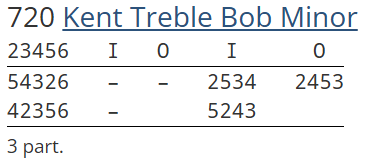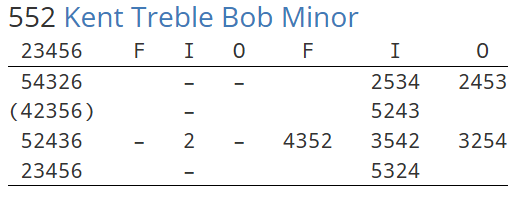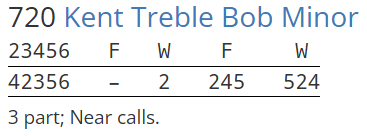Towards Mastery of Kent Treble Bob Minor - calling a Quarter Peal.
Ringing a quarter peal in the method is exceptionally valuable in that it is sufficiently long to enable the band to settle into a good rhythm, and to relax into “auto-pilot” ringing.
There are three ways of achieving a quarter peal using standard lengths:
- 2 x 720 = 1,440.
- 720 + 600 = 1,320.
- 720 + 552 = 1,272.
There is no obvious “best” combination of lengths for a quarter peal, it is entirely at the conductor’s assessment of the needs of the band and the experience of the conductor..
Most budding conductors will develop their experience by calling some short touches, and then use 2 of the following:
- 720: Tenor Observation, In & Out, In; repeat twice
- 720: 5th Observation, Out, In & Out; repeat twice
- 600: Tenor Observation, In, In, In & Out, Out, Out
- 552: (720 shortened) Tenor observation: In, Out, In, 4ths & In, In & Out In
- 552: (720 shortened) 5th observation: Out, 4ths; Out, In & Out; Out, In & Out
Conductor’s responsibilities:
- Ring one’s own pair correctly
- Make the calls
- Check that the ringing is correct
- Assist others to overcome trips.
Ringing Kent Correctly:
Earlier sections of this page give details on ringing Kent.
Extensive practice cannot and should not be avoided, aim to ring so many quarter peals or peals that you know the method, and can relax enough to think about the calling.
Making the calls:
Make sure you are good at calling Plain Bob Minor, following the coursing order, checking the bells are correct all the way through.
Don’t skip this.
a) Familiarise yourself with a number of different short touches of Kent, try them on Abel, see what comes naturally and what is more difficult.
b) Choose a composition that you like.
Most people will choose Tenor observation, and call In-Out-In-Out for a 240, and then In-Out-In repeated twice for a three part 720.
Call it off 5-6 and get the feel of what the pair does at the calls.
Don’t worry if it fires up, don’t try to follow the coursing order, just get confident at making the calls.
The exact point to say bob is as the treble rings at backstroke of the 1-2 down dodge.
Check for correctness.
a) About coursing orders.
In treble dominated minor methods coursing orders are a 5 digit representation of the working relationships amongst the bells.
It would be more correctly presented as a circle, but we present the order as a serial string of digits with the tacit understanding that the end digit links to the beginning digit.
The benefit of string representation is that the observation bell, which is crucial representing the composition is given a fixed place in the string.
Strings are also easier than circles to manipulate on a word processor.
The relationships amongst the bells changes with every call, and hence the coursing order is normally transposed to the order following the call leaving the observation bell unchanged in its position in the string.
This section challenges the normal approach.
As a touch progresses, knowing the current coursing order is vitally important, and is a skill that should be developed before trying to see the coursing order in action amongst the bells.
b) Follow the coursing order.
The normal advice for calling Tenor In-Out-In is to treat it like Wrong-Home-Wrong for Plain Bob Minor, but use CAB transpositions.
If you have the brains of a Cambridge Mathmo, that’s fine.
Normal mortals can make life easier, viz:
In-Out-In Tenor observation is exactly the same as Home-Home-4ths for 5ths observation.
So rotate the coursing order to 32465.
With 5 observation, its position at the end of the string is fixed, and the transpositions become BCA as follows:
| Plain Course: | 32465 |
| 5th Home: | 34625 |
| 5th Home: | 36245 |
| 5th 4ths: | 36524 |
Looking at this to understand how the bells work together:
| Plain Course: | 32465 |
| 5th Home: | 34625 3 & 5 dodge in 5-6, 4 out, 6 in, 2 makes the bob |
| 5th Home: | 36245 3 & 5 dodge in 5-6, 6 out, 2 in, 4 makes the bob |
| 5th 4ths: | 36524 2 & 4 dodge in 5-6, 3 out, 6 in, 5 makes the bob |
We now have 5 and 6 coursing together, so bring 2 and 4 to the front of the coursing order string to get 24365.
This coursing order takes you to the part end, change row: 142356.
Repeat the process, twice to get the 720.
| Plain Course: | 32465 | 24365 | 43265 |
| 5th Home: | 34625 | 23645 | 42635 |
| 5th Home: | 36245 | 26435 | 46325 |
| 5th 4ths: | 36524 | 26543 | 46532 |
| Adjustment: | 24365 | 43265 | 32465 |
Following the coursing order in this manner is an easier development step for the budding conductor, than to go straight to CAB transpositions.
c) See the coursing order.
A gradual build-up of skill is easiest, e.g.
Ring the 720.
Call the 720.
Call the 720 and follow the changes of coursing order either by transposition, or by learning them off by heart.
Try to see the coursing order when your pair are coursing (50% of the time).
For the trio of bells affected by the bobs (always includes the 6), the bell in the slow runs out at the bob,
this is a very useful checkpoint for confirming that a bob is to be called.
Develop the skill of seeing the coursing order in bite-sized chunks, i.e. one bit at a time.
In doing so, ring at goldilocks handbell speeds so you can ring your own pair on auto-pilot whilst thinking about the calling and looking for bells in the coursing order.
With good extensive practice, you will follow the coursing order more or less continuously, and thereby know the bells are correct.
Kent TB is the best TB method for this.
Assisting others to overcome trips.
If the conductor is ringing with confidence, and making the calls clearly, the band will settle into a rhythm, and trips will be minimal.
Missed places in Kent cause clashes but are not catastrophic beyond that.
Missed slow-work in Kent is more significant, it is worth-while as a ringer, let alone as a conductor to make a mental note of the slow bell at the start of every lead.
The bells enter the slow in coursing order.
Sometimes a band simply needs re-assurance that everything is OK, and a simple “Lead End now” at the appropriate point is helpful.
If you do need to speak to get a bell or pair corrected:
- a) Check your facts, make sure that you are right
- b) At the appropriate point tell the ringer(s) exactly what you want to have happen
- c) Re-assure afterwards (e.g. “all ok now”)
Just telling a 3-4 ringer that their pair is crossed is unhelpful, telling them to cross back is equally unhelpful; but telling them,
for example, that “4 should be coming down to lead followed by 3” is much more specific, unambiguous, and therefore much more helpful.
Further notes on Conducting Kent TB Minor.
The other popular 720 is to call 5th Observation: Out-In-Out.
This can be given the same treatment by re-working the coursing orders for tenor observation, the tenor rings 4ths-Wrong-Wrong.
In many ways this re-working is even better than the re-work for In-Out-In; viz:
Make the bob is a CDAB transposition, but view it as 6 jumping past the first 2 bells in the Coursing Order string to give Out, In, Make it,
and then immediately move the dodging pair to the start of the string.
| Plain Course: | 53246 | 52436 | 54326 |
| 6th 4ths: | 53624 | 52643 | 54632 |
| Adjustment: | 24536 | 43526 | 32546 |
| 6th Wrong: | 45236 | 35426 | 25346 |
| 6th Wrong: | 52436 | 54326 | 53246 |
Calling the 600
Tenor In, In, In&Out, Out, Out.
Complib:
600 Kent Treble Bob Minor

Diagram: Composition Layout, 3 x In, 3 x Out.
The calling sequence for the standard 600 is simply Tenor In, In, In & Out, Out, Out
with the touch returning to the Plain Course for one lead between the two blocks of 3.
The coursing orders are then:
| Plain Course: | 53246 |
| In: | 53462 |
| In | 54632 |
| In | 46532 | Out | 65432 |
| | Out | 65243 |
| | Out | 65324 |
For the 3 calls In, the 4 is a fixed bell, and in the slow each time, replaced by the 6.
For the 3 calls Out, Tenor is in the slow and 5 runs In each time.
Follow the coursing orders here by the bell making the bob: 6 out, 5 in, 4 makes the bob, etc.
The presentation of the coursing orders in this manner has the following benefits:
- Clarity of the slow bell preceding each call
- Cyclic work for 5, 3, and 2 for the 3 bobs In, indeed, 5 dodges Home (5-6 Down) at the first Bob just as it would in the standard 720,
and makes the bob in the last call In and comes back into coursing behind the tenor, just as it would in the standard 720.
So the only call/work that is not found in the standard 720 is where 5 dodges wrong (5-6 Up).
- When calling from 5-6 (recommended), the 3 bobs out leave 5-6 unaffected and the bobs work cycles around 4, 2, and 3.
NB. After the first bob In, 3-4 pair are coursing, with 3 before 4 (i.e. when the bells hunt down, 3 reaches the lead just before 4),.
For the rest of the touch, whenever 3-4 are coursing, 4 is before 3.
Shortening the 720s to 552
Both 720s can be shortened to 552 by inserting a shortening course.
In each case a single call replaces 2 normal calls and eliminates 168 change-rows.
See below for Complib links to the compositions referenced above:
The layouts are from complib and show the tenor as the observation bell.
Tenor In-Out-In
Complib:
720 Kent Treble Bob Minor

Diagram: Composition Layout, 720, In-Out-In
Complib:
Related 552 Kent Treble Bob Minor

Diagram: Composition Layout, 720 shortened to 552, In-Out-In; 4ths-In; In-Out-In
Fifth Out-In-Out = Tenor 4ths & twice wrong
Complib:
720 Kent Treble Bob Minor

Diagram: Composition Layout, 720, 4ths & Twice Wrong.
Complib:
Related 552 Kent Treble Bob Minor

Diagram: Composition Layout, 720 shortened to 552, 4ths & In, 4ths & 2 x Wrong, 4ths & 2 x Wrong.
|

